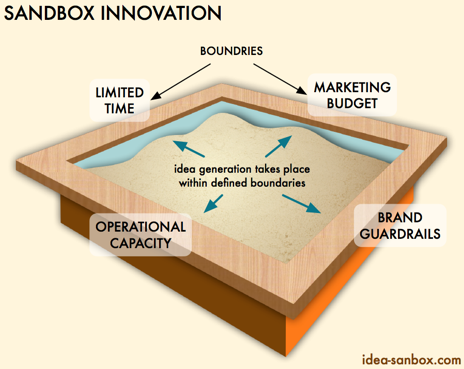The lead at your last brainstorm session probably preambled with something like this:
“Remember team, there is no such things as a bad idea in brainstorming. And there are no boundaries. Let the sky be the limit!”
They were correct.
Yet, the process of coming up with ideas to solve, grow, think or create is a process that expands and contracts. This is technically called divergent thinking (move apart) and convergent thinking (come together). I’ve compared this process to a roller coaster.
- We start with the broad issue that there is a problem or opportunity.
- We narrow that down to a laser-focused objective. What we are specifically solving. (This is sometimes called framing).
- Next, we go broad again – thinking up as many potential ideas as possible – in a world without boundaries.
- Finally, we go very narrow again – picking the best solutions for our challenge.
Despite ‘broad thinking’ and ‘suspending reality’ during idea generation, we have to re-evaluate those ideas within the walls of real constraints. We always work within boundaries and limits.
We have limited time, funding, labor. We are constrained by factory size, operational capacity, product shelf life, legal restrictions and brand guardrails.
These are like sandbox walls. The sand allows us to be as creative as we need. The walls define the realistic limits.
Sandbox Innovation
Sandbox Innovation is coming up with the great ideas that work within these restrictions.

Your goal is to not only promote the product, drive more sales, and get attention. But, do so in a way that is…
- engaging to the customer,
- that is meaningful,
- that doesn’t make your employees feel stupid to execute, and
- in a way that adds credibility to your brand.
You’ve got to check ALL the boxes. In fact, you could call this “Check All The Boxes Innovation” but that title isn’t as succinct.
Coming up with promotional ideas for Starbucks Coffee used to be extremely satisfying because of the challenge. The challenge of working within a limited budget, to support a product / service / program, in a way that didn’t overburden the barista (front line employee), that engaged customers, and that supported the brand.
Many are too lazy to work out all of the details. They ignore a wall or two, and the promotion/program comes across as sloppy and/or doesn’t meet the required objectives.
Sandbox Innovation uses boundaries as a way to push us into making a better, more meaningful programs.
Let me know what you think!
| Side Note |
| Idea Sandbox considers it dishonest to take something found in an old business book, rename it something clever, add a ™, and pass it off as a “proprietary business method.”
Unfortunately, branding something old with your own snazzy name happens quite often in the fields of innovation and marketing consulting. This behavior adds needless jargon, tricks clients, and creates bad juju. The topic of creativity and brainstorming already feels intimidating enough to some people without adding scientific-sounding jargon. We are made to feel that being creative is a talent restricted to those gifted at birth. This is not true. We are all creative. And, becoming more creative is as simple as practicing proven methods that have been around for ages. “Sandbox Innovation” is the closest thing you’ll see me come to this. I just happen to be lucky that a neat way to look at effective problem solving has ‘sandbox’ in the name. |
